New to sourdough baking? Here’s my easy Sourdough Bread recipe with thousands of success stories! Includes easy step-by-step videos and instructions, my best pro tips, troubleshooting, and everything you need to master sourdough bread baking. With over 1400+ 5-star reviews, this sourdough bread method ensures success on your very first try.
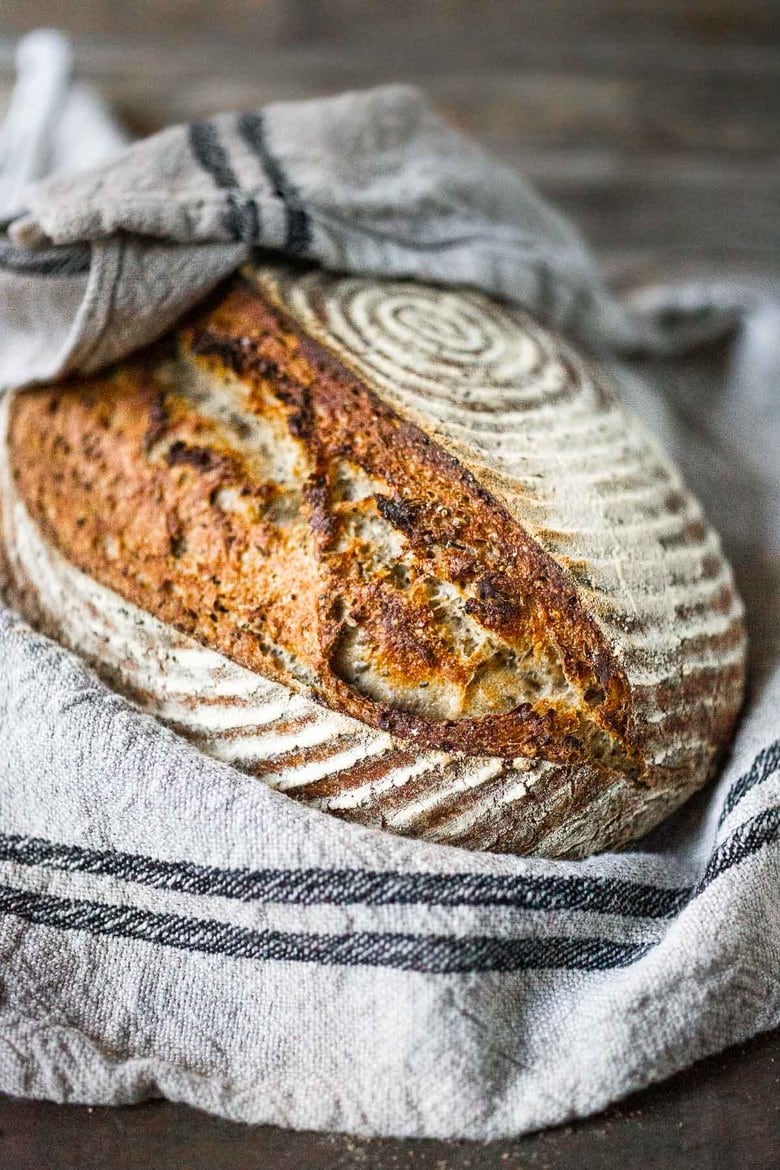
Are we free enough to open to the flow, no matter what it may contain?– Dorothy Hunt
We’ve tested and perfected our sourdough baking method to make it as simple as possible. This no-knead overnight sourdough bread takes 24 hours from start to finish with 45 minutes of hands-on time. Most readers have success with their very first loaf. Just read all the reviews!
Last week, I shared my method for an easy sourdough starter. By now, your starter should be ready to use, so I want to share my easy, beginner's recipe for no-knead sourdough bread that my friend Bee (H is for Love) taught me over 15 years ago! I’ve been refining and perfecting this method ever since, and it has proven to be foolproof.
This Sourdough recipe is flexible and easy, but most importantly, it works with my schedule. It doesn't require much hands-on time- although there is a tiny bit, just enough to make it feel wonderfully gratifying. The sourdough is made the night before and rises overnight on the counter (10-12 hours), before it is baked in the morning. Inversely, you can mix the dough early in the morning and bake it that night. It's very flexible and forgiving- even when you think you messed it up, it manages to surprise you with a beautiful loaf.
TIP: When searching for a Sourdough Bread Recipe (there are many!), the key is to choose one that fits your schedule. This allows you to easily incorporate bread-baking into your week without adjusting your plans. Always consider the hands-on and proofing times (usually two) to ensure it suits your schedule and lifestyle.
What Our Readers are Saying
One reader, Nidhi Vaidya says: “This recipe has never failed me! It always produces a beautiful loaf. Whenever a friend says they want to start sourdough, I point them this way.” ⭐⭐⭐⭐⭐
️Stephanie says: “This recipe is perfection! Easy to follow and fool-proof! I love to cook and have never been much of a baker and never made bread! I dislike store bought bread and am excited to make this wholesome bread weekly! “⭐⭐⭐⭐⭐
Ann says: “My previous attempts at sourdough were big fails, but I tried out this recipe and my sourdough loaf is picture perfect and delicious.” ⭐⭐⭐⭐⭐
Table of Contents
- What is Sourdough Bread?
- Why this sourdough bread Recipe Works
- Getting Started: What you need to know before you bake
- Sourdough Bread video (start-to-finish)
- No-Knead Sourdough Bread Ingredients
- What equipment do I need?
- Preparing your Sourdough Starter
- Sourdough Baking Schedule
- How to make Sourdough Bread (Step-by-Step Guide)
- Storing your sourdough bread
- Chef’s Tips for the Best Sourdough Bread
- Sourdough FAQS
- Practice Makes Perfect!
- More sourdough recipes you’ll love!
- More from feasting at home
- Sourdough Bread Recipe
What is Sourdough Bread?
Sourdough bread is made using a natural, fermented leavening agent (called a starter) that doesn’t require commercial yeast. The “starter” , a mix of flour and water that is fermented, contains wild yeast from the air and good bacteria. This is what makes sourdough bread rise and gives it its tangy flavor and light, chewy texture. Because sourdough is fermented and has no preservatives or additives, sourdough bread is easier to digest than store-bought yeasted bread, making it a much healthier option!
Why this sourdough bread Recipe Works
- Easy Schedule: Feed the starter in the morning, then mix the dough at night, proof it overnight on the counter (10-12 hours), and shape, proof (one hour) and bake it in the morning. (Alternatively, the dough can be made in the morning and baked at night). It’s very flexible and can be placed in the fridge if something comes up, and you can’t bake in the morning, slowing the process down.
- Simplified, Easy Process: We’ve removed all the complex and intimidating processes that deter beginners from even starting. It is pared down as much as possible, while explaining the “whys,” resulting in a beautiful loaf the very first try.
- This sourdough bread requires no kneading and no fussing – it couldn’t be any easier to make, thanks to several basic techniques that anyone can follow, which I walk you through in the videos.
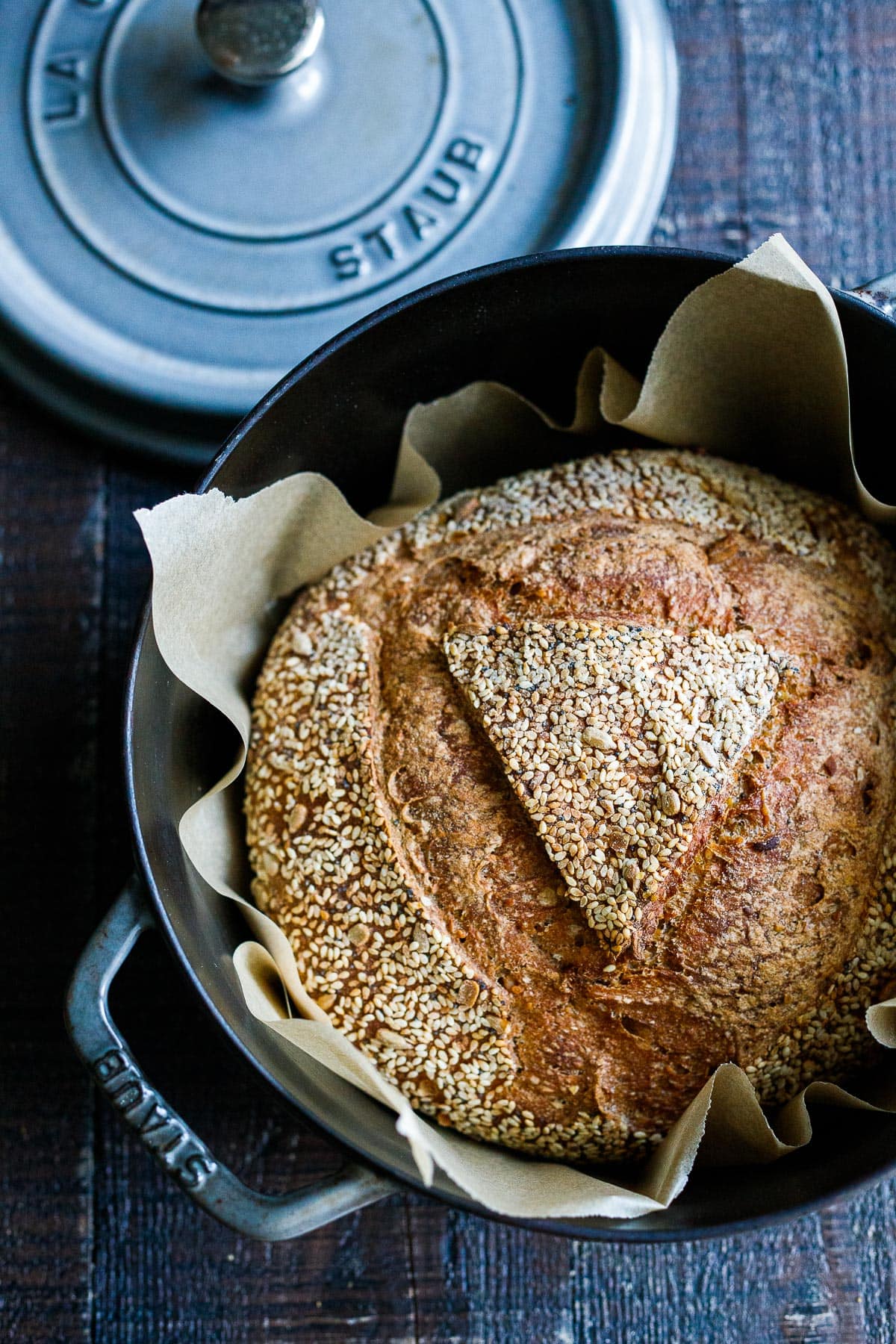
Getting Started: What you need to know before you bake
- The schedule. This no-knead overnight sourdough bread takes 24 hours from start to finish with about 45 minutes of hands-on time. You’ll feed your starter in the morning → mix the dough at night →let it proof overnight →shape it, and bake it in the morning. See our detailed baking schedule below.
- The starter. An active, happy starter is crucial to success here. Read through, preparing your sourdough starter below to ensure success your very first time.
- What you’ll need. Read through the ingredients list and the baking equipment list. Some items, such as a Dutch oven and thermometer, are essential here.
- Watch the video for a clear understanding of the process before you start.
Sourdough Bread video (start-to-finish)
This 16-minute, step-by-step sourdough video guide will walk you through the process of making sourdough bread from start to finish, with me personally. Don’t see the video? Ensure your ad blocker is disabled, try a different browser, or view the content on my YouTube channel.
***Scroll down to the recipe card for clear, detailed instructions
No-Knead Sourdough Bread Ingredients
- Sourdough starter – You can make sourdough starter at home (it takes 5-8 days) or purchase it here. To maintain it, store it in a jar in the fridge and feed it, like a pet. 🙂 Yes, you can even name it. If properly fed and cared for it can live for hundreds of years! My starter is called Vita.
- Flour – use organic bread flour and rye flour. All-purpose flour works in a pinch, but for your first loaf, bread flour produces a better loaf. You can substitute whole wheat flour for the rye.
- Water– use tap water, filtered water, or mineral water. Distilled water lacks minerals so don’t use that.
- Salt– fine sea salt or Himalayan pink salt
- Optional extras: rye flour, fennel seeds, caraway seeds, chia seeds, rice flour
What equipment do I need?
Here is what you absolutely need:
- A Dutch Oven – 4 ½-quart to 6-quart Dutch ovens works best. I use and love this 5.5 Quart Staub Dutch Oven because of its metal knob and dark interior (it’s easy to keep clean). But something as simple and inexpensive as this cast iron dutch oven will work. Here are my favorite Dutch Oven picks for Bread baking!
- High-Temp Parchment Paper– this “If You Care” Parchment Paper does not burn!
- A large bowl- glass or ceramic mixing bowl
- Measuring cups or a kitchen scale
- Sharp knife, razor blade or scissors
- Thermometer
- Kitchen towel or plastic wrap.
Here are some optional extras: rice flour, dough whisk, banneton, dough scraper and a lame (scoring blade). An oven thermometer is also nice (to double-check that your oven is calibrated).
We offer this Sourdough-Making Kit at our Bowl and Pitcher Shop if you are interested.
Preparing your Sourdough Starter
- Be sure your sourdough starter is active and happy! It should double in size within 6-8 hours of feeding. If it is not doubling in size, it will not rise your bread. For troubleshooting sourdough starter, please visit our dedicated sourdough starter page and scroll to the troubleshooting section.
- When making sourdough bread, use a starter either right at its peak, or after it has peaked.
- For a more “sour” taste, use a starter that is “hungry”, and hasn’t been recently been fed.
Sourdough Baking Schedule
Keep in mind that rising time is affected by weather and seasons. In winter, cold kitchens will lengthen the rising time. In summer or warm weather, hot kitchens will shorten the rising time. So this is a rough estimate based on 70°F weather.
- Morning (6:00 a.m. to 10:00 a.m.): Feed the sourdough starter. 8-12 hours before you plan to mix up the dough, feed your starter, allowing time to peak before using. (Or feel free to use an unfed starter for a more “sour taste”, straight from the fridge at 8 pm)
- Night (8 pm – 10 pm): Mix the dough. Do two sets of stretch and folds, 15 mins apart (see 1st video)
- Proof it Overnight. Cover the dough, let it proof (rise) overnight 8-14 hours at 65-70F on the kitchen counter.
- Next Morning (6 am-10 am) Shape and Bake. Check your dough when you awake, and when it has almost doubled in size, stretch, fold, and shape. ( see 2nd video). Place in a parchment-lined bowl, seam-side down. Place this in the fridge for 1 hour while you preheat the oven.
- Bake 20-25 minutes (or until internal temp reaches 200°F). Remove lid, and bake 10-15 more minutes, until very deeply golden and internal temp reaches 208F. Let it cool on a rack before cutting.
How to make Sourdough Bread (Step-by-Step Guide)
***Scroll down to the recipe card for concise measurements & instructions.
Step 1: Feed the starter in the morning.
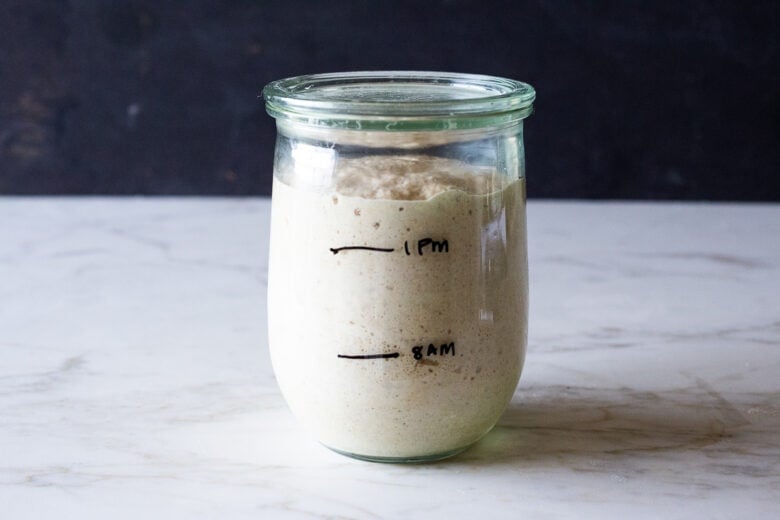
Feed your sourdough starter in the morning, 8-12 hours before making your bread dough -leaving it out on the counter and using it slightly after it peaks. Always use a slightly “hungry” starter. TIP: You know your starter is active and healthy if it doubles within 6 hours of feeding. In the evening, make the dough after the starter has peaked.
Step 2: Weigh the flour.
In a large bowl, weigh the bread flour (520 grams) using a kitchen scale, being careful not to include the weight of the bowl. Here I’m using roughly 4 cups of flour, spooned and leveled. (3 1/2 cups of organic white bread flour plus a 1/2 cup rye flour.)

Add two teaspoons of salt and, if you like, seeds; here I’ve added one teaspoon of fennel seeds, half a teaspoon of caraway seeds, and one tablespoon of chia seeds– I love this combination. Yes, you can add other spices and seeds. Get creative, but for the first loaf, I suggest going easy.
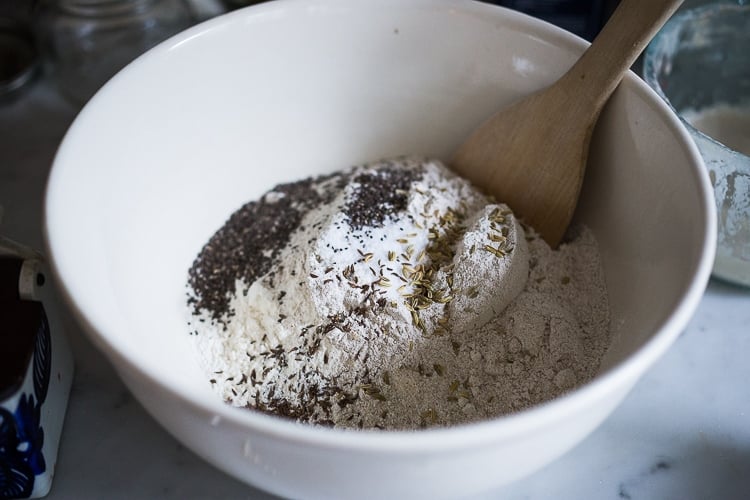
Step 3: Mix the starter with water.
Stir down the starter, then mix 1/3 cup of sourdough starter (90 grams) with 1 3/4 cups of water (385 grams) using a fork.

It will look like cloudy water.
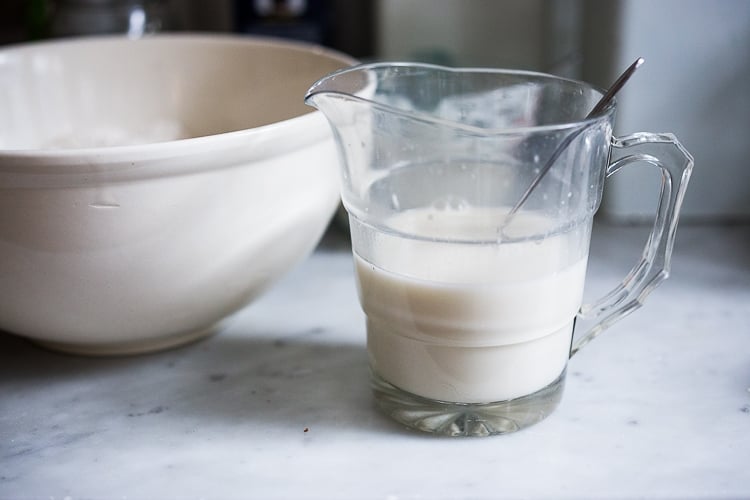
Step 4: Mix the dough (wet and dry ingredients).
Pour the starter-water mixture into the flour mixture and stir, using a fork, into a thick, sticky ball. Switch to a wooden spoon. Mix the dough for one minute to incorporate all the bread flour, using the wooden spoon. Just try your best to incorporate all the flour.
It will be thick, shaggy, and hard to mix. If the flour absolutely won’t mix in, then add a tablespoon of water at a time to incorporate it. Sometimes whole grain flour is “thirstier” than white flour, so you may need a little more water, a tablespoon at a time.
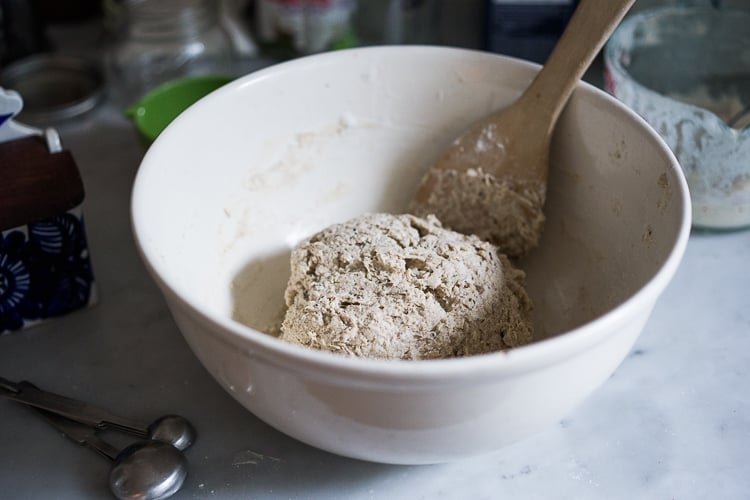
The dough will be heavy, thick and sticky (see photo above) to begin with, but will loosen up as it rests. Cover with a damp kitchen towel for 15 minutes, letting the dough rest.
Step 5: Stretch & fold technique #1 (Video)
Do two sets of “stretch and folds”, 15 minutes apart. This helps to build the gluten. Watch the first video below. With wet hands, stretch and fold. Let the dough rest 15 minutes covered, then repeat.
Stretch & fold video (Technique #1)
Don’t see the video? Allow 15-20 seconds to load it right here. If still not showing, check that your ad blocker is off, refresh the page, or try a different browser.
Step 6: Proof the dough overnight.
Cover the bowl with a damp kitchen towel (wet it thoroughly, then wring it out) or plastic wrap, and let the dough rise on the kitchen counter overnight 8-12 hours, at room temperature. This is called the bulk fermentation. Every environment is different, and seasons will affect the rising time. Warmer homes will proof dough much faster, colder homes, much slower. In midwinter in the Northwest, I’ve even proofed for as long as 18 hours on the counter. Here in Santa Barbara, in summer, the dough was ready in 8 hours.
How to tell if your dough is proofed correctly.
Tip: You can’t always look at the clock; you MUST look at the dough.
- Dough should be slightly domed, springy, somewhat jiggly like a happy, full belly, almost doubled. Shake the bowl and look for a happy jiggle.
- Do the poke test. Carefully poke the dough with a floured finger, 1/2 inch deep. If it is easy to indent, and the dough springs back, this is a good sign that it has risen enough. If the dough feels very firm and hard to indent, it probably needs to proof longer. If the dough doesn’t spring back, holding the indentation, or feels overly soft, bubbly, liquidy, or loose, it is likely over-proofed ( but still bake it).
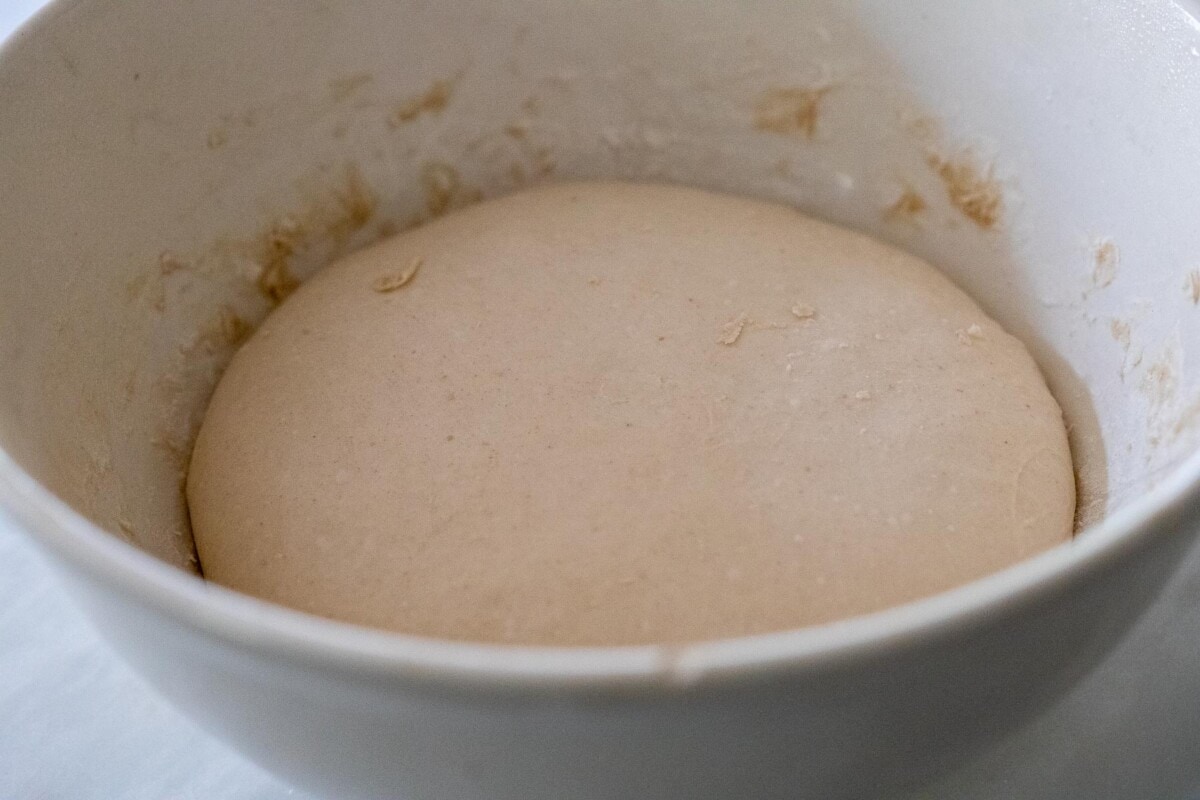
Prepare the shaping bowl. Place a piece of parchment paper in a bowl. I prefer using a high-sided, medium-sized bowl over a flat or shallow one to help shore up the sides. You can also use a banneton (scroll down).
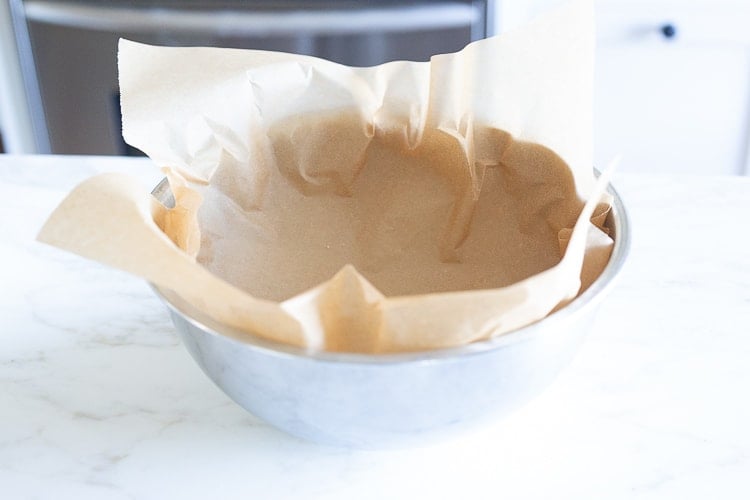
Tip on parchment paper: I use the “If You Care” brand of parchment baking paper. It is designed for high heat and does not stick or burn. If unsure about yours, spray it with a bit of olive oil to prevent sticking.
What is a banneton? And some tips.
As you progress in your baking journey, you may want to use a Banneton (bread-proofing basket below). A banneton is a ridged basket that makes pretty rings on the bread. If using a Banneton, use rice flour to prevent dough from sticking, and place any seeds on the bottom, placing the dough seam-side up (because you will flip it).
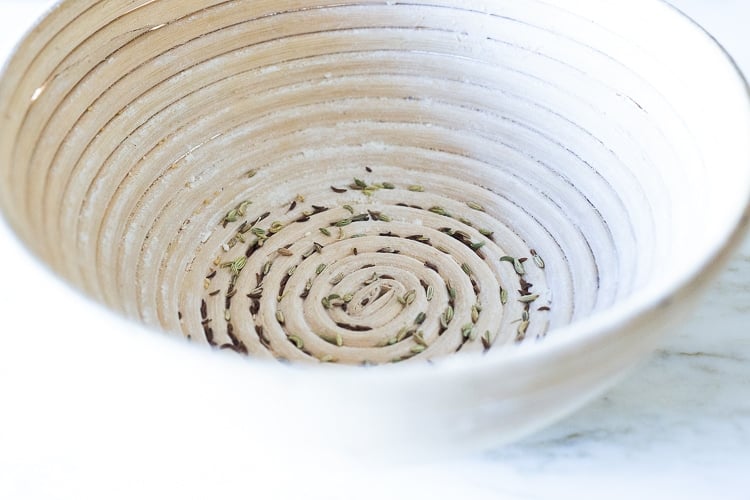
It can be a bit tricky to flip the Banneton into a hot Dutch oven and have it land centered. I prefer to flip it onto parchment paper, score, then place the parchment and dough into the hot Dutch oven. When using a piece of parchment paper in a regular bowl, there is no need to flip; simply lift the parchment and place it in the Dutch oven. Much easier than a banneton.
Step 7: Stretch & shape technique #2 (Video)
Watch the 2nd video below for our “stretch and shape” technique to use after the dough has been proofed. Loosen the dough from the edges of a bowl with a wet spatula or wet plastic dough scraper, sliding it down the sides of the bowl.
Stretch & Shape Video (Technique #2)
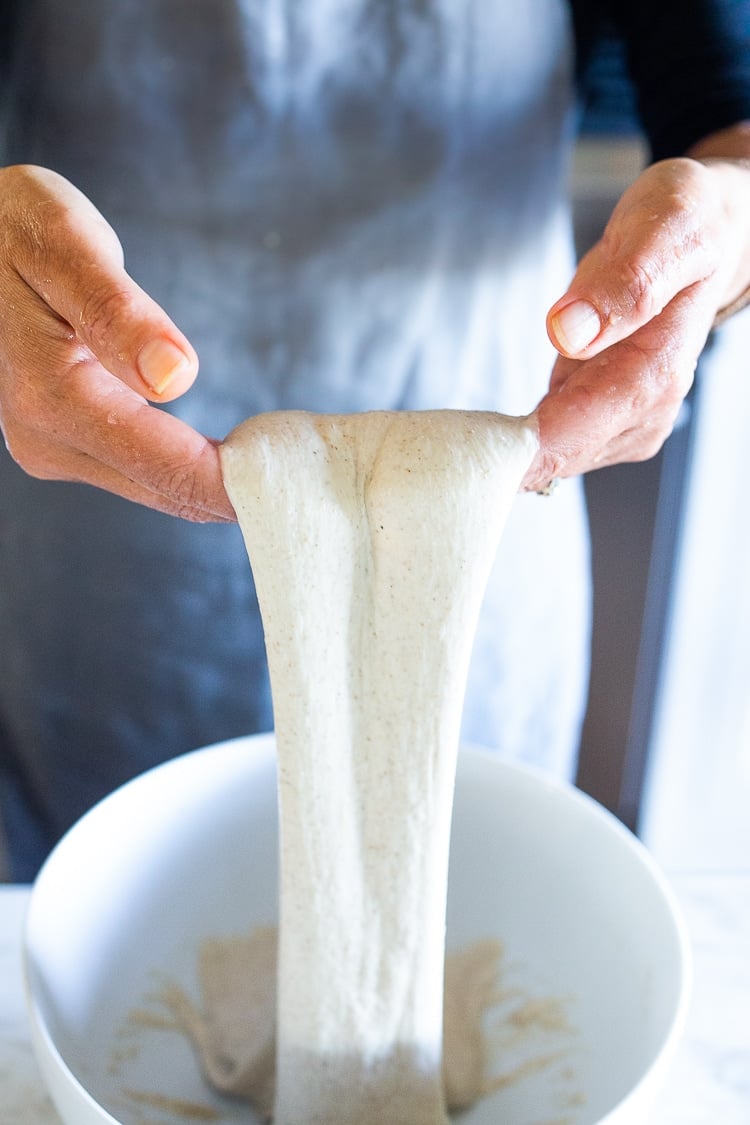
With wet hands, carefully pull the dough up on each side, lift it up about 1 foot high, and place it back down, folding it on top of itself gently.
Give the bowl a quarter turn and do this again with wet hands (repeat this 15 minutes later.) Then, the third time you lift and stretch, you will either lift it all the way up into your parchment-lined bowl, seam side down (easiest) or into the floured proofing basket, seam side up (pinching it closed).
As you see above, after proofing the dough overnight, it will become much looser. The starter has metabolized the flour overnight. This can be tricky to handle. However, using wet hands and learning the second stretch and shape technique in the second video above will make the wet dough much easier to handle. Trust me here. 🙂
After the second set, lift the dough into the parchment-lined bowl, seam side down. Many sourdough recipes call for placing the dough on a work surface to shape it, creating surface tension. You can do this, but this time we are skipping this step and using a stretch-and-shape technique instead, to keep it simple.
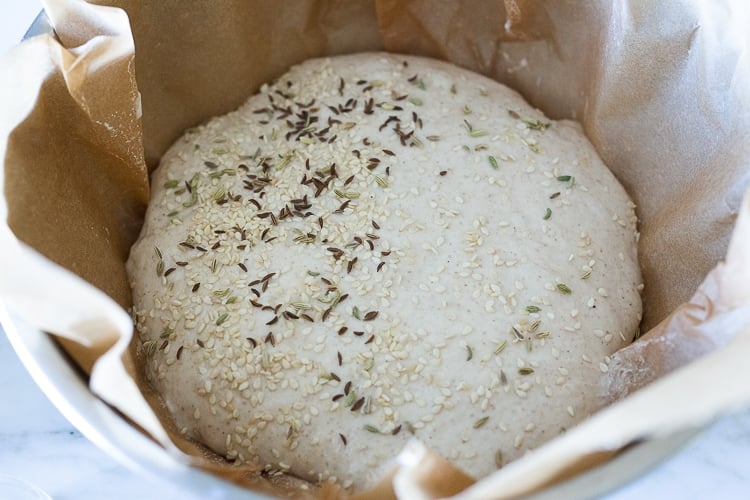
Sprinkle the top of the dough with seeds and dust with flour or rice flour (which makes it easier to score)especially if using the banneton, get those sides sprinkled well- so it flips out without catching!
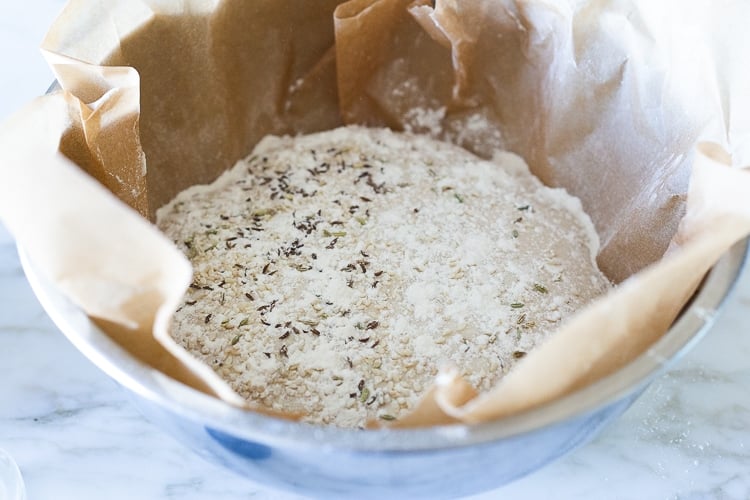
Step 8: Second “rise” and preheat the oven.
Place the dough in the fridge for one hour (or up to 3 hours) while you heat up the oven to 500°F with your Dutch oven inside (please see notes) for 60 minutes. Chilling the dough will make it easier to score and give it a little more “oven spring”. It is not really intended to rise here.
Step 9: Score the sourdough.
Score: Grease your blade or lame, and score the dough swiftly and deeply, at a 45-degree angle, 3/4 inch deep. Score where you want the dough to puff up. You can do one simple slash, a crescent, or a crisscross, or feel free to add other designs. (Just google sourdough scoring designs and be mesmerized for hours!) Oiling the knife helps. The lame really does make this 100 times easier!
Step 10: Bake it.
Carefully take out the Dutch oven from the oven and close the oven door. Remove the lid and gently lift your dough, holding onto the parchment corners, and lift it into the Dutch oven, and quickly cover. Place in the middle of the oven for 18-22 mins.
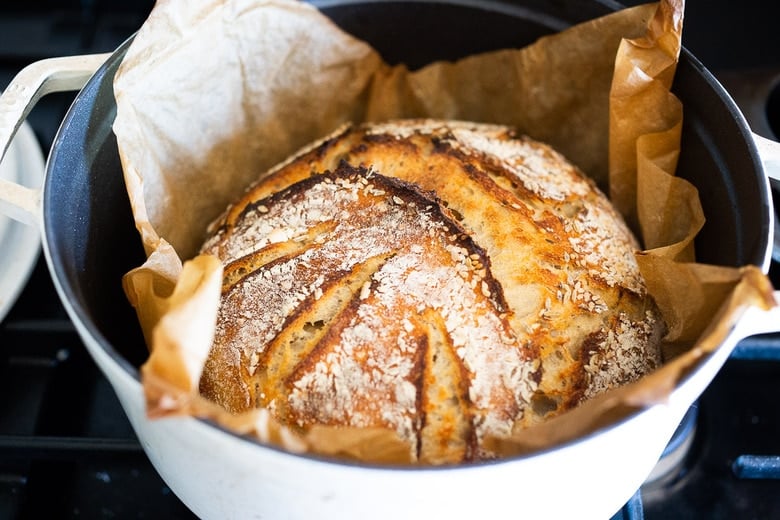
Remove the lid; it should be nicely puffed, lightly golden, and around 200F. This is your goal; if the temperature is not 200°F, replace the lid. Once the internal temp reaches 200°F, uncover and bake 10-15 minutes until deeply golden and internal temp reaches 208°F. Allow your loaves to get crusty and deeply golden. Let them go a bit longer than you might think.
Step 11: Cool and rest.
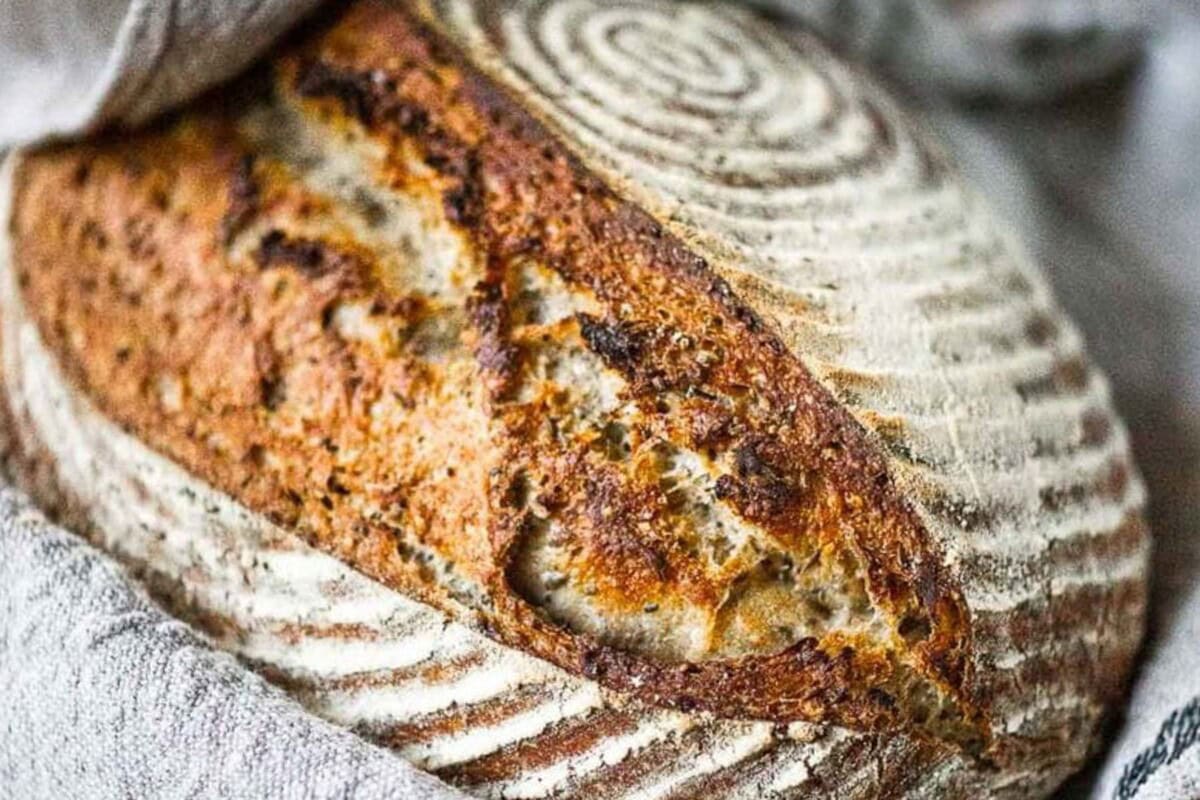
Remove it, place it on a wire rack, and let it cool completely before cutting. This is the HARDEST part! 😂 It will smell heavenly, and you will feel proud. Bask in it! It truly is an accomplishment!
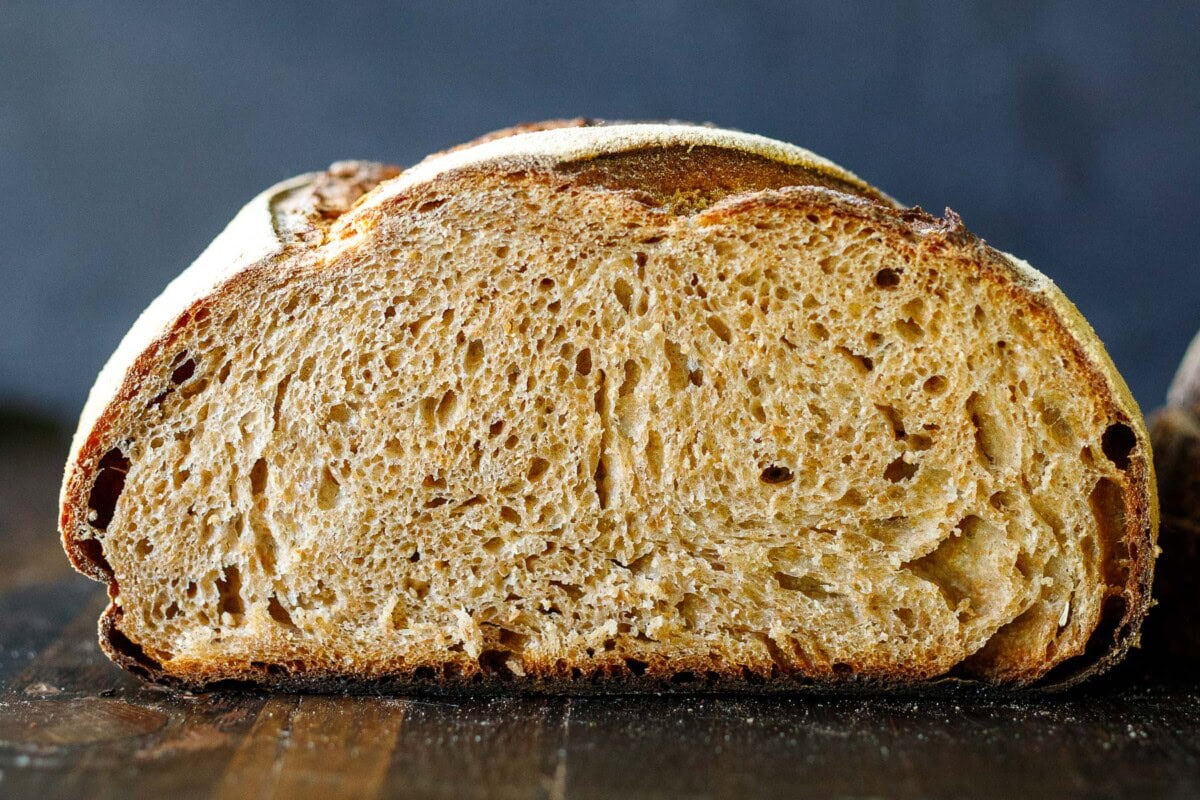
Storing your sourdough bread
- If you plan to eat your sourdough bread within one to two days, store it cut side down on a cutting board, covered with a kitchen towel.
- If you plan to eat within 3-4 days, store the bread in a paper bag, which will help keep the crust crisp.
- You can also store it in a plastic bag in the fridge for up to a week, but you will lose the crispy crust.
- Freeze (either whole or sliced) in a freezer bag for up to 3 months.
Chef’s Tips for the Best Sourdough Bread
- STARTER: Using your starter slightly after its peak will ensure your bread rises sufficiently. Make sure your starter is healthy, strong, and “hungry”, and doubles in size 6 hours after feeding. If you like a more “sour” taste, use an un-fed starter that has been stored in the fridge 5-6 days- and use without feeding it first.
- FLOUR: For your very first loaf, I highly suggest just using Organic White Bread Flour and be sure to weigh it. ***Please “zero out” the weight of the bowl. Weigh the flour without salt, seeds, or other additions. Try substituting a 1/2 cup of flour for another kind. For example, 3 1/2 cups white bread flour, plus 1/2 cup rye or whole wheat. If you add more whole-grain flour than that, your loaf will be quite heavy and dense. I really don’t want this for your first loaf, and neither do you. You want it to be amazing, so you feel inspired to make it again and again. So be patient. After several practice loaves -yes, feel free to experiment with other flours as much as you like!
- WATER: (Hydration) A wet dough will produce a lot of beautiful air pockets, but it is much harder to work with, in the beginning. A drier dough will yield a slightly denser, less airy loaf, but it will be easier to work with in the beginning. This one falls towards the latter – at 75% hydration- but you can easily adjust this down the road, as you practice, by adding a little more water or less flour in the initial mixing stage. To calculate the hydration level, you divide the water grams by the flour grams. In this case 385 divided by 520 = .75 or 75% hydration. As you get more comfortable, try for 80%-85% hydration, adding in a few extra folds at both stages.
- ADDITIONS: If you want to start adding things to your bread- nuts, olives, cheese, dried fruit, roasted garlic, etc., I recommend folding these in after it rises overnight. Use this recipe for Rosemary Olive Sourdough Bread as a guide.
- LONG COLD PROOF: After the first set of stretch and folds, cover and place in the fridge until almost doubled. This can take anywhere from 36-72 hours, depending on your fridge temp. It is easiest to see this in a clear glass bowl or clear-sided measuring container. Once almost doubled, pull from the fridge, let it come to room temp, do the second set of stretch and folds, let rise one hour, and bake.
- BAKING: Always preheat the oven. If you have convection, use it! Use a 4-6 quart Dutch oven: Make sure your Dutch oven can handle a 500°F oven. Plastic handles will melt. If not, 475F or 450F will suffice, but you’ll need to bake it longer (25-30-ish minutes) before removing the lid (remember the goal is for bread to be 200F when the lid comes off), then bake for 10-15 more minutes uncovered. Always check bread with a thermometer.
- TAKE NOTES: Note your rising times and baking times and adjust accordingly the next time. All kitchen environments and oven temps are different.
Sourdough Bread Variations
Once you master this sourdough bread recipe, you can get creative by adding more ingredients to the dough. This Rosemary Olive Sourdough Bread shows one approach, while our Jalapeño Cheddar Sourdough Bread shows a different method. When you feel confident, try our sourdough baguette recipe– a little more challenging, but totally doable!
Troubleshooting Sourdough Bread (when things go wrong)
- If your loaf is flat, hard, or has overly big holes. Likely the dough was over-proofed. It’s very easy to overproof dough in warm climates. You can tell if it is over-proofed if the dough is flat and runny, with lots of air bubbles at the top, or if it doesn’t spring back when you do the poke test, or if it breaks when stretched. Even still, you could try baking it (might as well at this point, right?). Do the 2nd video stretch and folds-it will be runny, so manage as best you can and put it in the fridge to firm it up a bit before baking.) Turn “imperfect loaves” into sourdough croutons.
- If your bread is gummy or dense, this can indicate your bread is underproofed during the initial overnight rise, or your sourdough starter wasn’t “strong/active” enough. Double-check that your starter is doubling in size within 6-8 hours of feeding (see our troubleshooting section in this Sourdough Starter post). This can happen if you are accustomed to baking in the summer and are now transitioning into winter; the kitchen is colder, so the dough will require longer proofing. Gummy bread can be turned into croutons.
- If your dough is not rising. This is most likely an issue with your sourdough starter- please read through this troubleshooting section. Double-check that your starter is doubling in size within 6-8 hours of being fed. Also, sourdough may not puff up as much as yeasted dough. It may only rise by 1 1/2 or 1 3/4 (not actually doubling in size). Just look for that slight dome and jiggly belly feel, and do the “poke test”. It should feel like a full belly with a slight dome and a bouncy spring to the touch. Check the temp with a thermometer. If it is under 70°F, it might just take a little longer to proof. If it is warmer, it may have peaked without you noticing, and now it is going down. If you want to be very precise about the rise height and time, you can measure the overnight rise in a 2-quart measuring container with clear sides the first few times to get an idea of the rise level and timing. It should rise by 1.5 or 1.75, so not quite double. I found this practice to be very helpful.
- The loaf is not crispy. This is likely due to not baking long enough, uncovered, in the oven.
- The loaf has no flavor. You probably forgot the salt. This is the most common issue if the bread is bland. Salt is imperative.
- The loaf is too sour. The “hungrier” the starter, the more sour the bread. Feed the starter 8-10 hours before mixing the dough for less sour loaves.
- The loaf is not sour enough. Try using an unfed starter. The longer it’s unfed (but within the 7 days) the more sour it will be.
- The dough is overly wet or overly dry. Many people accidentally mismeasure the flour because they forget to “zero out” the weight of the bowl or measuring cup on the scale! Check your weight (without seeds, salt or any additions) only flour.
- The bread is burnt on the bottom: Most typically in electric ovens. Try lowering the heat to 475°F with a slightly longer bake time (the goal is still to achieve an internal temperature of 200°F when you remove the lid). Alternatively, try placing a sheet pan under the Dutch oven (without preheating the sheet pan). Or add a layer of cornmeal below the parchment.
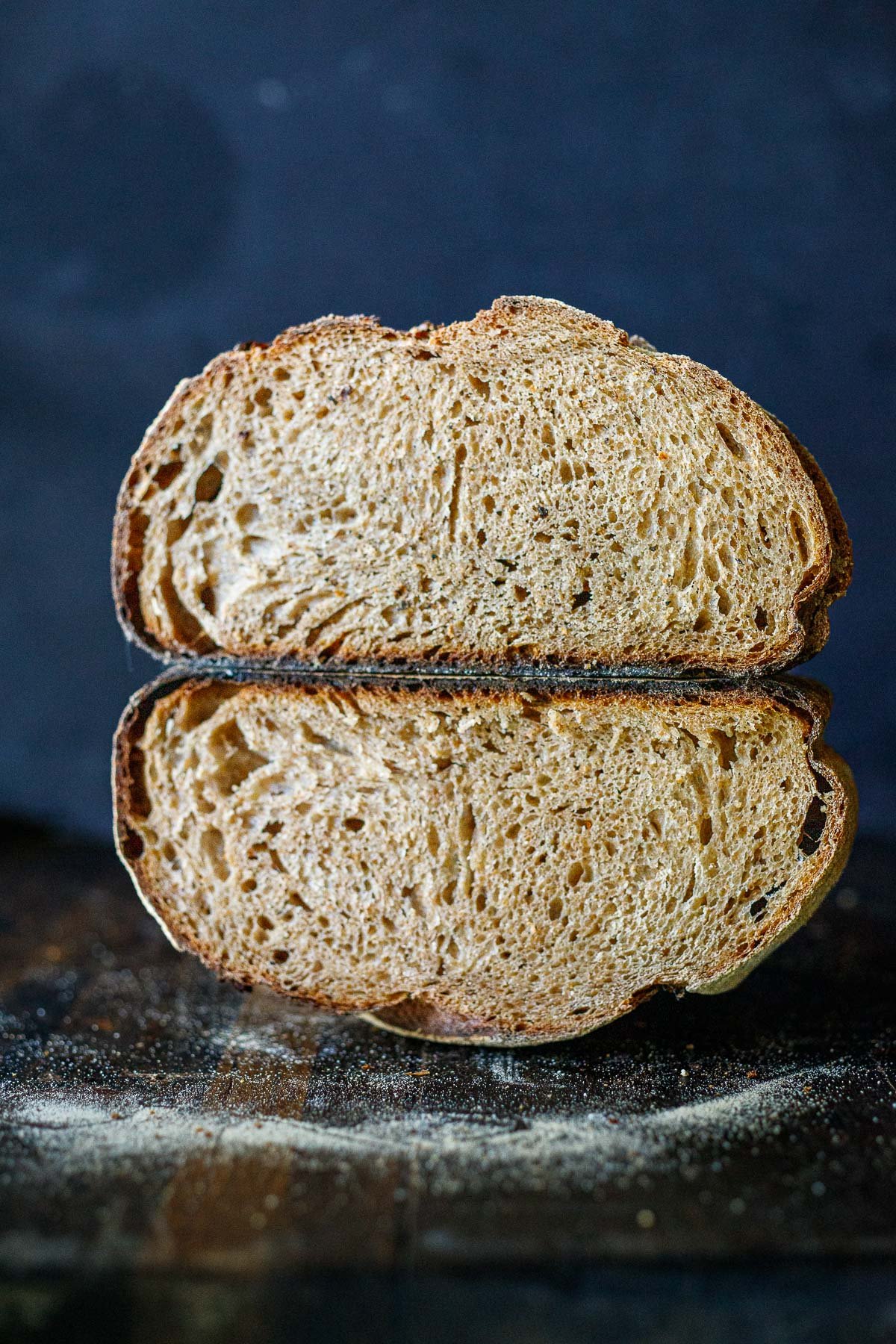
Sourdough FAQS
Sourdough bread is more easily digestible than bread made with commercial yeast, due to the natural fermentation process. This can be beneficial for people with gluten sensitivities. Sourdough bread, made with organic, non-GMO flour, is higher in nutrients and lower in glyphosates.
Bread made with sourdough starter has so much more flavor and complexity than yeasted bread. It is also much easier to digest because it is fermented. Many people who are gluten-sensitive do much better with bread made from sourdough starter.
If your bread is gummy or overly moist after baking, most likely, the dough was underproofed, or your starter is too young or insufficiently active. Try proofing longer, and double-check your starter is healthy and active and doubles after 6 hours of feeding.
Underproofing the dough can cause bread to be dense- by not allowing enough time for the carbon dioxide to develop and create the bubbles in the dough that create the airy texture. An inactive starter can also be the culprit.
Most likely, the sourdough has over-proofed and has collapsed, creating a flat hard loaf. It is still edible, but not as light and airy as it should be.
Besides the reasons above (underproofing the dough and an inactive starter), sourdough can be overly dense if you use too much whole-grain flour or not enough water.
Most likely, the salt was left out or mismeasured.
Active and healthy sourdough starter is the secret to perfect sourdough bread! Care and proper feeding of your starter will ensure your sourdough loaves are beautiful, flavorful, light, and airy. A Sourdough Starter that doubles in size within 6 hours of feeding is the best sign that the starter is healthy and active.
Practice Makes Perfect!
Baking sourdough is such a satisfying process. Making your first “good” loaf is the BEST feeling ever! Know that every time you bake, your bread will improve as long as your starter is healthy and active.
I suggest that you make the exact same loaf repeatedly, to get it down before changing any variables. Take notes each time. Consider this first month of baking as “practicing”. The most challenging aspect is getting to know your environment, including kitchen temperature, oven temperature, and timing, as well as ensuring your starter is healthy.
So just be patient, keep trying, and don’t give up. I promise you will get it -read the reviews for inspiration and enjoy the sourdough process!
After you try our sourdough bread, let us know how it turns out in the comments below. Your notes will also help other readers. Sign up here to join our community and receive our latest recipes and weekly newsletter! xoxo Sylvia
More sourdough recipes you'll love!
More from feasting at home
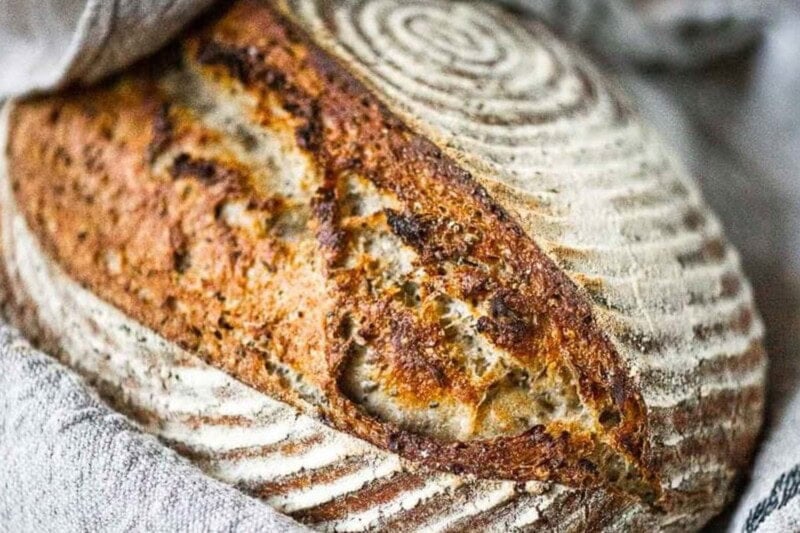
Sourdough Bread Recipe
- Prep Time: 13 hours
- Cook Time: 35 mins
- Total Time: 13 hours 35 minutes
- Yield: 1 loaf 1x
- Category: baked, sourdough recipes, baking
- Method: bread
- Cuisine: American
- Diet: Vegan
Description
An easy Sourdough Bread recipe that rises overnight and bakes in the morning. A simple flexible recipe made with sourdough starter, that can be adapted to your needs. View the 3 instructional videos above for more details. If you don’t see the videos, make sure your ad blocker is off.
Ingredients
- 4 cups organic white bread flour, spooned and leveled (520 grams total flour) -please don’t include the bowl’s weight. I highly recommend weighing the flour for the first few loaves. (See notes for adding other types of flour.)
- 2 teaspoons fine sea salt (12 grams)
- 1 7/8 cups water (385 grams)
- 90 grams homemade sourdough starter or store-bought starter (1/3 cup) fed 8-12 hours earlier, using it slightly after peaking (For a more “sour” taste, use an unfed starter, 4–6 days after feeding if refrigerated- see notes.)
Optional additions:
- rice flour (my favorite for dusting a banneton).
- Seeds for flavoring: fennel seeds, chia seeds, flax seeds, caraway seeds, sesame seeds, poppy seeds, dill seeds, celery seeds, nigella seeds, etc. (optional, but tasty) My favorite is 1 teaspoon fennel seeds, 1/2 teaspoon caraway and 1 tablespoon chia seeds
- Substitute 1/2 cup rye flour, spelt flour or whole wheat flour or other whole-grain flour for 1/2 cup of the white bread flour if you like- resisting the temptation to add more for your first few loaves. (62 grams max).
- Add herbs (fresh or dried- rosemary, thyme, sage, etc).
- Add nuts, olives, garlic, dried fruit or cheese (please see this Rosemary Olive Sourdough Bread Post, for more “how-to” instructions).
Instructions
- 8 am. Twelve hours before mixing your dough, feed your sourdough starter, leaving it out on the counter making sure it doubles in size within 6 hours. (See notes for extra sour). OR, if you keep your starter in the fridge and fed it in the last 7 days- it is OK to use it straight from the jar, cold, without feeding. Best to use starter after it peaks, when it is “hungry”.
- 8:00 pm PLEASE use a kitchen scale if this is your first loaf. Weigh the flour in a medium bowl (***zero-ing out the weight of the bowl). Then add salt, spices, and seeds. Mix starter and water in a small bowl until cloudy and well mixed. Pour the starter-water into flour, incorporating all the flour using a fork. It should be a thick, shaggy, heavy, sticky dough. See video. Mix for about 1-2 minutes using a wood spoon- it will be hard to mix. Don’t worry about tidy dough here, just get the flour all mixed in, cover with a wet kitchen towel, and let rest 15 minutes. It will loosen up as it rests. (Alternatively, mix starter and water in the bowl first, then add the salt and flour-like in my 3rd video- either way works.)
- 8:20 pm: Do the first set of stretches and folds. (See the 1st video in post) With one wet hand (put a bowl of water next to you) pull the dough from one side and stretch it upward, then fold it up and over to the center of the dough. Quarter turn the bowl and repeat, stretching up and folding it over the middle, repeat for about 30 seconds or until the dough gets firm and resists. This helps strengthen the gluten. Cover, rest, and repeat the process 15 minutes later. With wet fingers, stretch up and fold over, turning, repeating, for 30 seconds until the dough gets firm and resists. Then turn the dough over in the bowl. Yes, you could do this a couple more times if you would like to build the gluten, but not imperative. 🙂
- 8:35 pm Proof overnight, at room temp. Cover the bowl with plastic wrap, wax wrap, or a damp kitchen towel (to keep the moisture in) and place it on your kitchen counter for 8-12 hours. (see notes on temperature) 68-70F is the ideal temp. (If it is warmer, check at 6-8 hours. If it is very cold, it may take up to 18 hours in winter.)
- 6-8 AM Check the dough in the morning. The dough should have expanded, with a slight springy dome to the top. It won’t necessarily double in size ( maybe 1.5 -1.75 times bigger) but will have expanded. Do the POKE TEST: With a floured finger, poke into the dough. If it indents easily and mostly springs back to its original shape, it has probably risen enough. If it feels firm or very hard to indent, let it rise longer. If it feels loose, runny, or indents too easily or doesn’t spring back, it is most likely over-proofed (bake it anyway).
- Line a high-sided bowl with parchment. This brand of parchment does not stick to the bread- but if you are unsure about yours, spray oil your parchment lightly before putting the dough in it. (If you are a seasoned bread baker, you do not actually need parchment -this is only for easier transport, bread will not stick to the inside of a Dutch oven.) I like using a high-sided medium-sized bowl versus a flat or shallow bowl to help shore up the sides. You can also use a rice-floured Banneton (bread proofing basket) if you have one.
- 6-8 AM- 2nd Set of STRETCH and SHAPE : (Watch 2nd video -Stretch and Shape video). Loosen the dough from all edges of a bowl using your wet fingers, a wet spatula, or a wet plastic dough scraper, sliding down the sides of the bowl. With both wet hands, carefully pull the dough straight up, in the middle and lift it, stretching straight up in the air- about 1-2 feet (see photo) and place it back down, gently folding it on top of itself. In this first stretch, the dough may feel quite loose and runny. This is OK. It should firm up as it stretches and folds. (Note: If your dough breaks here, it is probably over-proofed, bake it anyway. If your dough won’t stretch like the photo and feels too tight or firm, it needs to proof longer). After the first stretch, give the bowl a quarter turn, wait 30-60 seconds, wet your hands again and stretch it up high again, folding over itself in the bowl. Wait 30-60 seconds. (You could repeat this one more time, 15 minutes later). Then, the third time you lift and stretch, you will lift it all the way into your parchment-lined bowl, folding over itself like you’ve been doing. (Alternatively, lift it into your floured proofing basket seam side up. ( If seam up, pinch the seam closed). Sprinkle top with seeds and flour (get the sides too), gently rubbing it to even coat –and add seeds if you like. If using a banneton, sprinkle the seeds in the banneton before adding the dough.
- FINAL RISE and PREHEAT OVEN: Place the bowl in the refrigerator for one hour uncovered which will firm up the bread, and make scoring easier and help boost “oven spring”. It won’t rise in the fridge. (You could also keep it in the fridge for 3-4 hours if you want to bake later.) Preheat the oven (for 1 FULL hour) to 500F with your dutch oven inside and lid on (see notes). If you have convection- use it. You can also bake the bread at 45oF or 475F. You want your oven as hot so don’t skimp on the preheat. I usually preheat for 1 full hour.
- SCORE & BAKE When ready to bake, place the dough by the stove. Pull out the Dutch oven, close the oven, and remove the lid. Score the bread in the bowl, using a very sharp knife, lame, razor blade, (or try scissors dipped in cold water), score the dough swiftly and deeply, at a 45-degree angle, 3/4- 1-inch deep. One deep slash is just fine. Or criss-cross, or crescent shape. (Or feel free to add other designs, for ideas -google “scoring bread”). You want to score where you want the dough to puff out from. You can also cut with wet kitchen scissors. Carefully lift the parchment by the corners and place both bread and parchment directly into the Dutch oven. Cover quickly. It is OK if parchment peaks out. You want to score and transfer as quickly as possible. (Alternately, if using a proofing basket, cover the basket with parchment, carefully flip the dough into the parchment in the palm of your hand and then center the parchment and dough into your dutch oven, then score).
- BAKE. Place the Dutch oven in the middle of the 500°F oven for 20 minutes with convection on, or 25 minutes without convection (or 28 minutes at 450°F). Remove lid. It should be puffed and just lightly golden, and the internal temperature should be close to 200°F (if not, put the lid back on for a few more minutes). Once it’s 200°F, lower the heat to 450°F, and bake uncovered for 10-15 minutes until deeply golden and the internal temperature reaches 204-208°F. No pale loaves please, let them get golden! (For a less “crusty” loaf, increase covered baking time, lower uncovered baking time. You can play with this for the desired results.)
- COOL: It will smell heavenly. Remove from the dutch oven, let it cool 1 hour on a rack or tilted up on its side, before slicing so you don’t let the steam out and don’t smash it- be patient. This is the hardest part. 😉. Take a picture! Feel proud. You did it!
- SERVE: This type of bread is always BEST, served toasted! Then lather it with butter, ghee or olive oil. Add mashed avocado and salted tomatoes, almond butter, honey or jam. A piece of toast can turn into a great meal. See this Mushroom Toast!
- STORE: Store the bread wrapped in a kitchen towel for the first day or two to keep the crust nice and crispy, then move it to a zip-lock bag or waxed bread bag to keep it moist for longer. Bread can also be sliced and frozen. Make sourdough croutons with leftover bread- great in salads and soups!
Notes
Sourdough starter : Using your starter after its peak will ensure your bread rises sufficiently. Make sure your starter is healthy, hungry, and strong, able to double in size 4-8 hours after feeding. If you store your starter in the fridge and last fed it over a week ago, make sure to feed the morning before making bread. If it has only been 3-7 days since last feeding (and you keep it in the fridge), it is OK to make bread without feeding. Use a 1/3 cup starter for your bread dough and place the remaining back in the fridge and feed a week after the last feeding. BUT if it has been a week after your last feeding, pull it out of the fridge, discard (or save for pancakes, waffles, or give away) all but 1/2 cup. Feed it. Let it metabolize the flour 4-8 hours before mixing up the bread dough. Use a 1/3 cup of starter (90 grams) for the bread, place the remaining back in the fridge, and feed in a week. For a more “sour” flavor, use starter that has been in the fridge 4-6 days. Do not feed before using it. The sourdough starter is the sourest the longer it goes without feeding.
Dutch Oven or Bread Baker: Make sure your dutch oven or bread baker can handle a 500F oven. If not, 450F will suffice, and bake 25 minutes before removing the lid. Aim for an internal bread temp of 200F when removing lid- before baking it uncovered. Take notes and adjust the next time!
NO DUTCH OVEN? If you don’t have a dutch oven, you can try baking your bread on a sheet pan, covered with a large metal bowl or pyrex bowl to keep the steam in. It will yield a flatter loaf but it does work. Bake 25-30 minutes covered, remove the bowl, bake until golden 10-15 more minutes until golden, and be sure to check internal temp with a thermometer. It may take a few practices tries to perfect this.
Smaller Loaves: If you would like to create two smaller loaves, divide after the overnight rise, shape, place in the fridge while the oven preheats and bake each at 450F for 18 minutes (or until internal temp is 200F) uncover, lower heat to 425F and bake until golden and internal temp is 204-208F. You may have to fiddle with this timing.
LOAF PAN: Yes you can bake this in a loaf pan. Shape and place it in an oiled loaf pan ( or line with parchment) for the last hour in the fridge, while oven preheats. Bake uncovered at 450 for 15 minutes, lower heat to 425 and bake another 25-ish minutes or until internal temp reaches 204-208F. You may need to play with this according to your oven. Place on middle or lower rack.
PRACTICE: As you practice making your loaves (yes, it is a fun practice) you’ll get a feel for the dough and you’ll begin to notices how changes in seasons (changes in temperature) affect the loaves and their proofing time. I suggest making the exact same loaf repeatedly several times. Warmer temps will call for shorter proofing, cooler temps, longer proofing. You can also change the proofing time by adjusting the sourdough starter amount. For a faster rise, you can add a little more starter, for example, a 1/2 or 2/3 cup. For a longer cooler rise, say in the fridge for 36-48 hours, you can reduce the starter amount to 1/4 cup or even 3 tablespoons. You can play with ratios to get the proofing time just how you want it. Take notes! You can also adjust the hydration for an airier loaf, either reducing flour or increasing water. So many variables!!! *Remember your starter and your dough are actual living “creatures” that are affected by your particular environment. The most important advice I can give you is to pay close attention to your particular “creature”, observe it carefully, and look for signs- it is communicating with you. Pay attention. 🙂 Work with it, not against it. Be patient, respond thoughtfully.
Perfecting bread is a lifelong process, and I’m still learning too. 😉
Nutrition
- Serving Size: 1 slice ( 1/12 of a loaf)
- Calories: 154
- Sugar: 0.2 g
- Sodium: 582.3 mg
- Fat: 1.1 g
- Saturated Fat: 0.2 g
- Carbohydrates: 32.7 g
- Fiber: 4.9 g
- Protein: 6 g
- Cholesterol: 0 mg
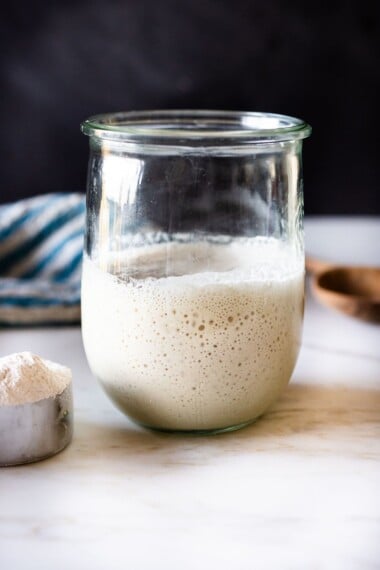
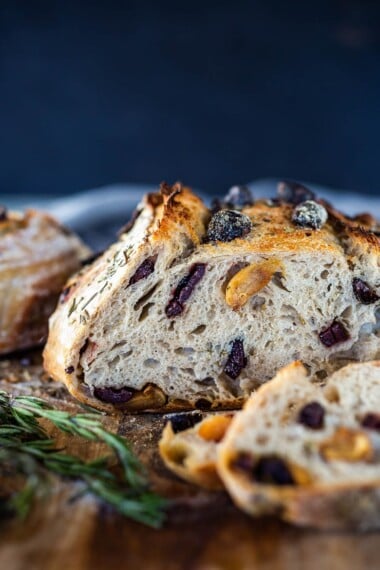















Hi, Sylvia:) can i use less starter to slow proofing a bit? Let’s say 50 g?
I think that should be fine!
Thanks 🙂 and more thing: how long can i keep my bread in the fridge before baking? I want to fit into my schedule for the weekend 🙂 some bakers leave it for 12-24 hours in the fridge and get good results.i’m afraid the bread might collapse and i will bake a brick eventually… Or should I take a leap and experiment? 🙂
You will just have to watch it- it really depends on your fridge temp. It may take a couple of tries to get the timing right! But it can be done!
Shoot, forgot to mention that, too…yes, it was about 210. I’ll say I got rave reviews on the flavor!!
Hello!
I made this bread over the last two days, so easy for a first-time bread maker! It tastes pretty good, looks great, but is gummy. I watched your video and the dough looked just like yours, wondering what your thoughts are on why it might have turned out gummy? Cooked 20 w/ lid, 15 w/out lid. I did use “hungry” starter as I want sour bread. Can’t wait to try again, but after a bit of research…don’t want another gummy loaf ; )
Thank you!
Forgot to mention that I proofed in banneton and must not have added enough flour, as the dough stuck. Removed, then placed in bowl w/ parchment, but alas, it stuck to that, too! So, tried a third time – on parchment but w/ loads of flour and let it rise again (30), to try to undue all of the manhandling. It did rise up a bit…then baked. Could all of that contribute to gumminess?
Rice flour is the key to having the dough not stick in the banneton!
Hi Kim- Did you take its temp? Was it 200F when you pulled off the lid?
Kim,
you probably need to let it rest longer after you take it out of the oven.
since this recipe yields a loaf around 1000g when baked, you should let it sit 8-10 hours before slicing (if regular bread flour) or 10-12 hours before slicing (if there is wheat and rye flour).
Like a few bakers mentioned, I also had problems scoring and tried everything that was recommended. However, I think, I found the perfect answer for me: scissors dipped in cold water.
Works every time.
Thanks for this Monika!Great tip!
Thank you! One less tool to buy! Making my first loaf this morning!
Made this yesterday. Everyone was telling me to tamper my expectations, and it was okay if the bread didn’t look like the ones we buy at an hour artisanal bake shops…
It came out perfectly. Have this recipe printed out and ready to double it for the next time.
So glad this worked for you! Such a great feeling!
Hi Sylvia,
If I keep adding my weekly discard starter to my discard batch in the fridge, from previous discards, is there a max. fridge storage time for it before I have to use it up. Is adding weekly discard to it, like feeding the starter? My discard has a brownish liquid, like the hooch on the starter, on it. Can I just stir it in the discard and use it? Thanks!
Still haven’t figured out how to score. I don’t have a lame. Not sure if it’s my lack of scoring technique or the addition of extra rye flour, not enough tension on my dough, or what . . . ?
Btw, your recipe with 35% rye flour is delicious.
Hi Andrea, Glad the rye turned out for you! I usually toss the discard after a week or so- if I’m not using it and is building up. I would pour off the hooch before using it. AS the discard sits in the fridge without feeding, it will just get more and more acidic – and lose its “rising power” so just smell it and decide if you want to use it. Oh and using a lame will greatly help you with scoring. Also refrigerating before scoring. Using a knife is just harder!
So love your website and am grateful for your support! Thank you.
What lame would you recommend? Looking to try to get a good ear, and maybe some additional simple design.
Do you also have a recommendation for an oval and for a round Banetton to hold the amount of dough in your recipe? I think that’s just under 1 kg of dough. What style do you like to use?
Thanks kindly.
The bannetons and Lame I use are linked in the post!
Hi Sylvia,
Thanks so much for your comment about cutting back on the percentage of rye flour I’m using. I’ve only made about 4 – 5 loaves, and experimenting to try to increase the sourness of the loaf, but still don’t quite understand what effect each of the changes I make have on the outcome. Until I came across your recipe I was intimidated to even try to bake a sourdough loaf. Thank you for your clear instructions on your website and for all the support. It’s amazing!
thanks, Andrea- let me know how it goes!
Okay, Miss Sylvia, I’ve made this bread several times now – mostly with great success but with one colossal flop. I’d overproofed it in the oven with just the oven light on and the next morning it was more like cake batter than bread dough. Oops.
Hubby and I agree this bread makes the best toast, but we’d prefer a loaf shape over the “hunk-a-bread”, as he calls it. So he bought me two cast iron loaf pans. They aren’t enameled cast iron, but I have reseasoned them a few times and they are ready to go. Tonight I’m doing an experiment.
I’ll make the bread dough all the way up through the refrigeration step tomorrow. I’ll do the fridge proofing in a loaf shaped Banneton and while it’s being refrigerated I’ll preheat both loaf pans in the oven. Then I plan to bake the bread in one pan and flip the second one over it as a lid. Rather than rely on baking times, I’ll let the bread set up a bit then put my trusty thermometer probe into it and set the alarm for 200 degrees. When that happens I’ll remove the lid and let it bake until the reading is 208. At the same time I’ll observe the baking time it took for each step.
So, any little hints you can offer? Any thoughts on the idea? And should I share the results? I plan to make this tonight. I don’t refrigerate my starter so it gets fed twice a day and lives on the counter. We find we prefer a slightly sweeter bread than super sour so this works for me. I used your starter instructions but once it matured and performed reliably I dropped my amounts to 90/90/90. It’s now 3 months old and reliable as all get-out.
I did try to post this earlier but it didn’t post. So if it suddenly duplicates with slightly different wording, that’s why.
Hi Diane, cake batter dough is way over-proofed. Probably too warm in the oven. Just try leaving it on the counter overnight? If baking uncovered in a loaf pan- bake at 425F. One batch should make one loaf pan. Make sure dough rises just slightly above the edge.;) Good luck and let me know how it goes.
If I want a longer cooler bulk rise in the fridge, to get a more sourer loaf, do I put my dough in the fridge before I start the first set of stretch and folds and then do them while the dough is cold?
If my dough is cold will it still have the same signs as being slightly domed, springy, bouncy, jiggly and almost doubled in size to know when it is done?
If I do my first rise in the fridge, can I continue with a second rise in the fridge, after shaping, for up to 24 hours to get a sour loaf? Or will that be too much?
Thanks for all your help!
You can do all your rises in the fridge- the problem is it’s hard to know for how long. If you watch it carefully and experiment, yes, it can be done, and it may take way longer than 24 hours depending on your fridge temp. Putting it in a clear measuring container so you can clearly see the rise from the side will make this easier to gauge. But it may be easier to get a more sour loaf, by just letting your starter go longer without feeding.
Thanks so much Sylvia. When should I do the first set of stretch and folds? Before the refrigerated bulk ferment or after?
Before. 🙂
Thanks so much!
I am using your dough recipe with an unfed fridge starter at day 7 with 65% bread flour and 35% rye flour.
With 35% rye flour do I need to add extra water, and if so how much more?
If I autolyse just the bread flour would I use 65% of the total water in the recipe for this process?
Once autolyse is complete, do I add all the rest of the ingredients together or leave out the salt until some time later?
Any help is much appreciated.
Thank you kindly.
Hi Andrea, have you experimented with this recipe prior to this? If not I would suggest sticking to the 1/2 cup rye for your first loaf-so you get a feel of the dough-because adding more rye here will make it quite heavy. If you wish to stick with 35% rye, yes, you may have to add more water. I haven’t made it this way so I don’t know the exact amount, it is such a “feel” thing. I would say add just enough water to incorporate all the flour. If starting with autolyse, you may want to look up a different recipe that details that? It sounds like you are a pretty experienced baker and this recipe is more of a beginner’s guide. I really like this website- The Perfect Loaf. Here is a link to the autolyze:
https://www.theperfectloaf.com/guides/how-to-autolyse/
Sylvia,
This recipe is fantastically do-able for me! The flavor is wonderful with the addition of the seeds.
Love this recipe so much, that I’ve made 3 loaves over the last couple of days. I would like to know your recommendation on how to freeze the loaves whole?
Thank you again
Thanks Diana- so glad this is working for you. I usually just wrap in plastic wrap or use a large zip lock.
Thank you so much for putting this recipe together. I have tried several attempts to make sourdough bread and have had very little success. I made my first loaf today and I am so happy with how the loaf turned out. I so enjoy your site. I have made several recipes and they have been exceptional. Teri
I am so thrilled for you Teri! Congrats on your first loaf!
Love this recipe. So easy and working very well.
What I’d like to know is can I use a rye flour starter?
Do I need to change any of the weights of ingredients?
Yes Thomas, you can use a rye flour starter. I would feed your starter according to our starter recipe for most accurate results. But I also think it would just work fine as is here as long as your starter is doubling within 6 hours of feeding.
Excellent. Thanks for the advice and thanks also for the prompt response
Hi Sylvia, I love this recipe so much and really appreciate the details! One quick question about the last stretch and folds- my dough never seems to stretch very much, maybe 6-8 inches or so. Is it not proofed enough? it’s usually after sitting all night and the poke test seems to be good. Any suggestions would be great. thanks!!
Yes, your hunch is right on. I’d let it go just a bit longer.
Layla —
I believe the lack of stretch is because you haven’t developed enough gluten 🙂 Maybe try Coil and Folding for the second stretch 🙂
Thank you so much for your videos and recipes. i followed your starter recipe and it worked well. I accidently followed another recipe (by someone else) for sourdough bread, and it didnt work out. second attempt i followed this one and it was great! so thank you!
if i wanted to make a sultana and cinnamon loaf – what measurements of sultanas and cinnamon would you suggest? also should i soak the sultanas before, or will the dough plump them up while proofing?
Glad this worked Mel! I havent tried with sultanas- sounds delicious though! You may just have to experiment.
Hi Sylvia, I love your clear instructions and have been making loaves for a couple of weeks now. Thank you so much. I’m delighted with them! I have an issue with timings. At the moment, it’s summer and very hot so the dough is only taking six to eight hours to proof. A couple of times, I’ve overslept and the dough has over proofed. Can I put it in the fridge overnight and then let it rise on the warm countertop in the morning before doing the second set of stretch and folds? All the best, Vicki
I think that is a great idea Vicki, give it a go!
Excellent! Followed your instructions to a tee. First, I used your sourdough starter recipe to make my starter, and then used this recipe for my very first sourdough loaf. Felt a little ambition so went for a little extra hydration 80%. My first loaf turned out amazingly well, thank you! Will definitely be sharing this one.
congrats and thanks Maria!
I love this recipe – I also followed your starter recipe to the dot and with great results. Today I am out of bread flour and will be using organic all-purpose. As per my research should use about 15grams less water. Wish me luck
Let me know how it turns out!
worked well thanks
Awesome Lars!
Hi Sylvia,
Your recipe and instructions are so fabulous! Thank you, thank you!!
I must be missing a key component to sourdough making. After I did my bulk rise during the day, I attempted to do the poke test, which I understand in principle. However, when I gently poked the dough it just stuck to my floured finger and pulled away from the surface. So I thought that maybe it needed more time?? After another half hour the same problem. Eventually after repeating the poke test every 20 – 30 minutes, I got tired and wanted to go to bed so I put my dough in the fridge overnight. Why can’t I do the poke test, as the dough is so so so sticky?
In the morning my dough had a lot of large bubbles on top but it was impossible to do the next stretch and shape as the dough broke as soon as I tried to lift it. I tried to wait 20 minutes to try it again, but the dough was more soup-like now than dough-like. I poured the dough into my parchment lined bowl, without any shaping as the dough had no texture at this point, and baked it after putting it in the fridge while heating up the oven.
I wasn’t going to even score the bread coming from the fridge but thought I had nothing to lose so I tried. To my complete surprise I actually got a better score than on my first two loaves. Can’t understand why?
After letting my loaf cool for about 40 minutes or so I cut open my bread to see what a disaster I created and was surprised again that the taste was quite nice and had a lovely sourness to it, but it was slightly gummy.
Any tips about poke test to proofing would be greatly appreciated.
Much thanks!
It sounds very over-proofed. Were you planning to bake it at night? I think proofing during the day will result in a faster proofing period (because it is generally warmer in the day vs. night). Try it again, and perhaps just look at the dough. If it is at least 1 1/2 ( or 1 3/4) times the original size, I’d just start the second set of stretches and folds and go from there. When baking Use a thermometer to check the bread is close to 200F when you pull off the lid.:)
Andrea —
you overproofed :p maybe put some flour on your finger next time too!
As for the gummy texture, let it rest longer after you take it out of the oven.
since this recipe yields a loaf around 1000g when baked, you should let it sit 8-10 hours before slicing (if regular bread flour) or 10-12 hours before slicing (if there is wheat and rye flour).
Hope this helps!
Can I leave in the fridge for more than an hour before baking?
Yes, sometimes I leave for 3-4 hours. 🙂
Such a detailed recipe! It worked perfectly, even the first time! I’m using this recipe every week now, experimenting a little with different seeds and flour every time. Thank you so much for sharing your knowledge!
Yay Stella!!! Glad this worked for you!
I just want you to know that I followed your Sourdough Starter recipe first, and despite the fact my starter took a few more days than expected, your help and guidance/troubleshooting helped make it so my starter finally took off. Last night/Today, I moved on to using your recipe for No-Knead SD bread and between your videos and attention to detail, my loaf came out amazing. Thank you so much!
Awesome Kristina! congrats!
I have made this recipe I am guessing a dozen times now. It tastes great. I have used both a feed 6-8 hours before and unfed from the fridge and both result in the same type of loaf. It gets a nice crust on the outside but is slightly gummy on the inside. I have used all the trouble shooting suggestions you have in the recipe – starters doubles as required, temp is where it needs to be, etc. But the bread is still slightly gummy. Is this loaf meant to have a dryer crumb? If so, what else can I do? Also, I cannot get this loaf scored properly. It tears the bread. I’ve used a knife, a lame, oiled, not oiled. It’s really sticky even with the addition of rice flour a nice hangout in the fridge for 1-1.5 hours. Any suggestions for that?
Hi Amy, what type of flour are you using?
Hi, apologies for the delay. I am using Robin Hood bread flour (460g) and whole wheat (60g).
Hi Amy, I would try switching up the bread flour. I always have good luck with Bob’s Red Mill Artisan bread flour. Do you have access to that? Also just be sure your starter is happy and active, doubling within 6 hours of feeding. 🙂
Hi again Sylvia, I should have access to that flour and will look for it when I run out of the stuff I have. However, I think I finally solved the problem. I was using a inaccurate thermometer. I bought a new one recently and wow was I ever under baking! Added another 8 minutes to the baking time with the lid at 500F and another 5 minutes to the baking time without the lid at 450F. I think my internal oven temperature is not actually reaching the required temps inside, leading to me initially under-baking. The addition of a good thermometer solved that today! Best loaf yet! (Note: all loaves have been delicious)
Awesome Amy- great to hear! so glad you figured it out. A thermometer is so helpful here!
Also Amy!
the gummy texture is likely due to your resting time after baking.
since this recipe yields a loaf around 1000g when baked, you should let it sit 8-10 hours before slicing (if regular bread flour) or 10-12 hours before slicing (if there is wheat and rye flour).
Hope this helps! Baking is science <3.
I love me some science! Next time I will wait your recommended time.
Love this recipe. I’ve loved baking most of life but always struggled with making really good bread (it’s been more cakes and biscuits and sweet things).
Now this sourdough bread recipe is brilliant – works every time for me and it is super delicious and my family loves it too.
I’ve been adding some rye flour (about 100gms worth) and a couple of handfuls of sunflowers seeds, also a half a teaspoon of guar gum. Baking in a simple oven proof round bowl, lined with parchment paper, and I put a plate over it as a cover. Seems to work well 🙂
Thanks again.
Love this Neal- glad its turning out for you!
Hi! I would love to try your recipe soon! Been craving for sourdough bread recently. If I were to add some cheese cube like gruyere, which step should I put in at?
Check out the recipe for Rosemary Olive Sourdough Bread and it will show you where to add- after the first long proof, before you shape.
Hi Sylvia. I’ve been using your recipe for a long time now, with some loaves slightly more risen, some less, but always with lovely holes, lovely crust and lovely taste. Definitely sometimes over proofed and perhaps under but the weather where I was and am now is completely unpredictable!
My question this time is, is there any possibility of baking this dough in a traditional bread tin? I have moved countries and all my entire life is boxed up. Where I am now we don’t have a dutch oven to use, and bought a rectangular sourdough loaf from a market. It did not taste half as good as yours, and I would really like to try make a loaf shape for my elderly Mom who can only eat sourdough bread.
Could one perhaps cover the tin and put water underneath to create steam?
I would so appreciate it if you do have any suggestions. Thanks so much in advance!
I have tried baking this in an oiled loaf pan- uncovered, 20 minutes at 435, then 20 more minutes at 375F. You may need to play with this and use a thermometer.
Nadya,
I have always made my dutch oven! I put boiling water in a few empty pans 10-min before popping the bread in the oven!
Temperature needs to adjust too from this recipe, so what I do is:
starting temp: 450 F
Once i stick it in the oven, I turn it up to 500 F.
After 22 minutes from putting the bread in, I take out the pans with water to stop the “dutch oven” and turn down the heat to 400 F / 390 F for at least 30-min or when crust is dark golden brown!
If you find the first 22 min isn’t forming the ear well, then start at a lower temperature and/or spritz the bread with water after flouring the top! Good luck!